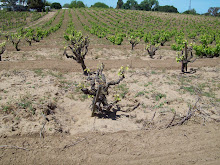
Maaaan, we discovered yet ANOTHER local vineyard that Kathy and I have never heard of! This is starting to get ridiculous.
Not only are there dozens and dozens of old-vine parcels everywhere we turn in Oakley, Antioch and Brentwood — none of which are identified by any signage indicating who owns, farms or sells to which wineries — but now we’ve come across one more winery that purchases Contra Costa County grapes from a single vineyard source near our house: a source whose name we’ve never seen on any of the CoCo labels of local wines we’ve already drunk as part of this project.
Kath and I moved from Seattle to Oakley, California almost one year ago. Oakley and surrounding cities and towns are studded with great plots of ancient, wizened, gnarly-headed century-old grapevines that have produced fruit for hundreds of wineries all over the state. Unfortunately, as distinctive as these old vines are, our ‘hood has no American Viticultural Area status, which I think is an absolute injustice. AVAs (think “Napa Valley” or “Russian River Valley”) are a federal distinction indicating that a particular growing region is different enough from another that its appearance on a label pinpoints wine specifics characteristic of the region.
Oakley’s official AVA designation is “San Francisco Bay,” which ludicrously includes portions of seven counties and the faraway city of San Fran itself, and which extends to the Pacific Ocean. It’s such a ridiculous designation that many winemakers don’t use it, instead just slapping “Contra Costa County,” which is not a real AVA, on the label. It, at least, attempts to give a real sense of place to the wine.
But, “Livermore Valley” is an honest-to-goodness legal AVA about 25 minutes south of us in Oakley, and it’s home to dozens of wineries, from established playahs such as Concannon and Wente to boutique outfits run by folks who’ve only just made the leap from home winemaking.
Longevity Wines, located in a tidy industrial park in Livermore, CA is just such a boutique operation. Owners Phil and Debra Long run a small-production facility, purchasing grapes from growers all over the region. Phil had been making wine at home for years, and when friends wanted to buy their juice, the Longs decided to jump through all the legal hoops; they went commercial in 2008.
A visit to Longevity in January was the highlight of that day’s tasting tour, and although they don’t own any of their own vineyards (“Yet!,” says Debra.), their grape contracts, sometimes on a handshake, combined with Phil’s deft touch at the tanks, yield some tasty results.
One of which just happens to be a CoCo 100% Syrah from a small vineyard site just a couple of miles from our house, near the border separating the city of Oakley from the small unincorporated town of Knightsen. The plot is variously referred to as the Newcomb Palidino Vineyard, the Newcomb Palatino Vineyard, and, in at least one printed Public Notice, Two Knights Vineyard. Whatever its name, we’ll try to track it down in time for our next post.
In the meantime, Kath and I enjoyed Debra and Phil’s 2006 Longevity Syrah Contra Costa County sourced from said patch o’dirt. Opaque purple in the glass, the 2006 demonstrates its unfiltered treatment, as well as its little bit of extra bottle maturity. Kath got whiffs of coffee and a touch of bacon on the nose. On the palate, there’s some rambunctious acidity and forward cherry/cranberry flavors with a slightly dusty, earthy finish. Kathy thought that this rowdy fruit-forwardness might be a sign of younger vines.
Lemmee do a bissel research; maybe we can get some answers next week.




